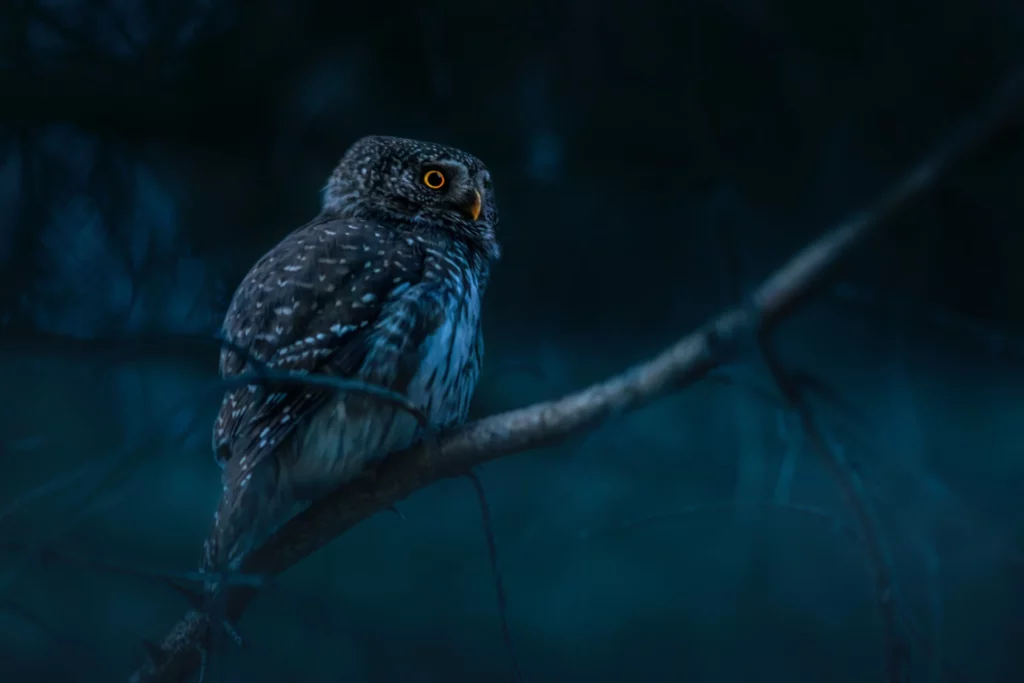If someone asks you to name a wise animal, what’s the first animal that comes to your mind? I’m pretty sure your answer is an Owl! Yes, there is an age-old saying that owls are wise animals. But have you ever wondered why? It is because of their eyes!
Owls are some of the very few species of birds that have eyes like us humans. Let’s discuss what makes owls’ eyes so special and also answer the question “Can owls move their eyes?”. Keep reading to find out!
Can Owls Move Their Eyes?
Can owls move their eyes? The answer to that is no! But why is that? Well, the thing is, owls don’t actually have “eyeballs” like us or other birds. Their eyes are actually connected and tube-shaped.
Their eyes are designed in such a way that they are held in place by bony structures called Sclerotic Rings. These rings hold their eyes in a fixed place.
There are both advantages and disadvantages to that. For example:
- Having such eyes allows them to see in the dark more efficiently.
- It helps them focus on their prey.
At the same time,
- It limits their vision range.
- It limits other eye features.
What Is Special About Owls Eyes?
Did you know that Owls can’t roll their eyes? Yes, it’s true; owls, in fact, cannot move their eyes at all. Nature designed their eyes to be special. But what makes owls’ eyes so special? Let’s find out!
1. They Have Built-in Binoculars!
To start off, owls have binocular vision. What does that mean? Well, having a binocular vision means you can see anything with both eyes at the same time.
2. Owls Have Twisted Vision
Next, owls have the amazing ability to rotate their heads. They can rotate their heads on both sides and have a range of 270 degrees! Wait a minute. If they can twist their necks like that, what if they snap off their spine or accidentally break their necks?
Again this is where the magic of mother nature happens. You see, owls have double the number of vertebrae in their necks. This allows them to be extra flexible!
3. They Can See In The Dark! Night Vision

This should be of no surprise to you as owls are primarily nocturnal (meaning they are active at night). But now the question arises, how do they see in the dark?
Well, as it turns out, owls have large corneas and pupils. Pupils are the openings at the center of the eye. The pupil is basically a small hole through which light enters the eyes. So since they have big pupils, more light enters their eyes.
When light enters our pupils and reaches the retina, we see an image forming in our heads. In the case of owls, they have a lot of light-sensitive cells called rod cells. These cells give them the ability to detect objects accurately in low light, even when the objects are moving. So this makes owls excellent hunters.
For example, even if a rat or small rodent is moving very fast in an otherwise dark environment, owls will be easily able to lock into them!
4. Built-in Visors or Dust Shields!
You heard that right; yes, owls even have protection to protect their eyes against dust and debris. Unlike us humans, with 2 eyelids for each eye, owls instead have 3 eyelids for each eye.
With human eyelids, only the upper lid is moveable. It hydrates our eyes, and we use it to blink or close our eyes when we sleep. But when it comes to owls, they can control all 3 eyelids, and each of them has a specific function!
Their upper eyelids close to allow the owls to blink and hydrate their eyes.
The bottom eyelid closes when the owl is sleeping.
The third eyelid is a membrane called a nictitating membrane. Its job is to protect the eye from dust and debris, and other external factors.
5. Mentionable Features
Here are some mentionable features of Owls’ eyes:
- Owls are farsighted, which means they can see objects clearly that are far away. This also means that they have trouble seeing things near them clearly.
- Owls only see a limited number of colors. This makes them Monochrome (Here Mono means single or 1, chrome refers to color)
- Owls see the world in 3D like humans, so they are able to see the length, width, and height of objects at the same time!
- During day time, owls can shrink or contract their pupils independently. This allows them to control the amount of light that enters their eyes!
Conclusion
Owls are truly majestic creatures! Even though there are lots of myths surrounding them, they’ll always remain symbols of wisdom.
Sadly the owl population has been declining to the point that many species of this bird are even enlisted as endangered.
So I hope now that you know more about them, you’ll raise awareness about these endangered birds among your friends and family!

